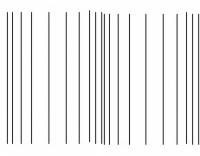Sound and radiation recording on vigils

Sound
Sound is a pressure wave. It requires a medium (like air or water) to propagate, unlike electromagnetic (EM) waves. It is a little difficult to visualize. Unlike EM waves which are transverse, like waves in a pond, sound waves are longitudinal. They look more like the motions of the bellows in a concertina (see pic above).
Unusual sounds are probably the commonest symptoms of hauntings. Therefore, you should obviously take sound recorders on vigils. However, there is an argument that you should use video instead so that it is possible to identify sound sources after the event. However, sound quality is unlikely to be as good as on dedicated sound recorders.
One thing you many people report with sound recorders on vigils is that they pick up sounds not heard at the time (like EVP). In many cases this is down to the high sensitivity or directional properties of the microphone or simply that people didn’t notice or remember quiet sounds.
Radiation detectors
It might seem odd to take a Geiger Counter on a vigil but, since we don’t know what ghosts really are, why not? ASSAP has used radiation detectors for many years. Some odd readings have turned up at haunted sites though nothing conclusive. Unusual radiation effects were found to be associated with Stone Circles in the Dragon Project. It certainly appears to be a worthwhile avenue to follow. You might just find something new.
Radiation
There are three common types of natural radioactivity; alpha, beta and gamma. Alpha radiation consists of Helium nuclei (an ion made up of two protons and two neutrons). Alpha radiation typically has a short range (a few cm in air) from its source.
Beta radiation consists of electrons. Beta radiation has a longer range in air (metres) than alpha and can penetrate thin sheets of aluminium.
Gamma radiation consists of very short wavelength electromagnetic waves. Gamma rays have a long range and can penetrate metals but is (mostly) stopped by lead.
There is always a background level of radioactivity anywhere on Earth. It is produced mostly by radioactive decay of minerals and also as a result of cosmic rays from space. Significant amounts of background radioactivity are also nowadays caused by human activities.
The most significant single source of radiation, by far, in the built environment is radon, a radioactive gas. Radon emits an alpha particle. However, it decays into so-called ‘daughter’ products which are also radioactive. These emit more alphas as well as gamma rays (and even beta). As a gas, radon can spread widely. It is a decay product of uranium and is common in areas where there is granite in the local geology. Buildings in such areas (and others) may include granite in their construction.
Ultrasound tape measure
There are devices on the market called ultrasound tape measures. They can be useful for measuring room sizes. They measure distance by bouncing ultrasound off distant walls or other objects. One problem is that, like the laser thermometer, their ultrasound spreads out as a cone, increasing in size with distance. So they can be confused by objects closer than the one you are measuring if they happen to fall within the cone.
Radioactivity detection
Obviously, when you select a radiation detector, you need to know what types of radiation it measures. Typically, some detectors work on beta and alpha (ionising radiation) while different machines are needed for gamma rays.
As with any instrument you use for research, it should have a display showing an actual reading, not just a buzzer that goes off for high levels of radiation. You should note that radiation detectors often have a specific lifetime after which they are no longer reliable.
One particular problem with some radiation detectors is that they are subject to interference from electromagnetic fields. This should be pointed out in the manual. If not, try using the meter near an old-fashioned cathode ray tube TV screen and see if it goes nuts! If it does, you should use the detector in conjunction with an EMF meter to cross-check.
As with any instrument, you need to establish baselines. In particular, you should check out what is a ‘normal’ background reading in a variety of places. Remember that, background radiation in buildings can differ a lot due to (a) building materials, (b) ventilation and (c) any local sources of radiation that might be present (such as old luminous clocks, though these ought to be very rare).
Radon is heavier than air and can accumulate in certain places. So don’t be surprised to find pockets of slightly higher radiation. Do your measurements in the middle of rooms, well away from the walls, floor and electrical equipment. Even in that position, radon could be drawn across a room by draughts.